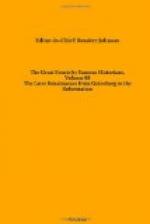In the mean time the rivalry encouraged by the court of Rome between the religious orders soon procured the Pope a champion eager to combat Savonarola; he was a Dominican—the general of the Augustines, that Order whence Martin Luther was soon to issue. Friar Mariano di Ghinazzano signalized himself by his zeal in opposing Savonarola. He presented to the Pope Friar Francis of Apulia, of the order of Minor Observantines, who was sent to Florence to preach against the Florentine monks, in the Church of Santa Croce. This preacher declared to his audience that he knew Savonarola pretended to support his doctrine by a miracle. “For me,” said he, “I am a sinner; I have not the presumption to perform miracles; nevertheless, let a fire be lighted, and I am ready to enter it with him. I am certain of perishing, but Christian charity teaches me not to withhold my life if in sacrificing it I might precipitate into hell a heresiarch, who has already drawn into it so many souls.”
This strange proposition was rejected by Savonarola; but his friend and disciple, Friar Dominic Buonvicino, eagerly accepted it. Francis of Apulia declared that he would risk his life against Savonarola only. Meanwhile a crowd of monks, of the Dominican and Franciscan orders, rivalled each other in their offers to prove by the ordeal of fire, on one side the truth, on the other the falsehood, of the new doctrine. Enthusiasm spread beyond the two convents; many priests and seculars, and even women and children, more especially on the side of Savonarola, earnestly requested to be admitted to the proof. The Pope warmly testified his gratitude to the Franciscans for their devotion. The Seigniory of Florence consented that two monks only should devote themselves for their respective orders, and directed the pile to be prepared. The whole population of the town and country, to which a signal miracle was promised, received the announcement with transports of joy.
On April 17, 1498, a scaffold, dreadful to look on, was erected in the public square of Florence; two piles of large pieces of wood, mixed with fagots and broom, which should quickly take fire, extended each eighty feet long, four feet thick, and five feet high; they were separated by a narrow space of two feet, to serve as a passage by which the two priests were to enter and pass the whole length of the piles during the fire.
Every window was full; every roof was covered with spectators; almost the whole population of the republic was collected round the place. The portico called the Loggia dei Lanzi, divided in two by a partition, was assigned to the two orders of monks. The Dominicans arrived at their station chanting canticles and bearing the holy sacrament. The Franciscans immediately declared that they would not permit the host to be carried amid flames. They insisted that the friar Buonvicino should enter the fire, as their own champion was prepared to do, without this divine safeguard. The Dominicans answered that “they would not separate themselves from their God at the moment when they implored his aid.” The dispute upon this point grew warm.




